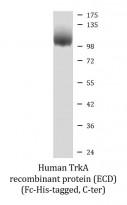ARG70244
Human TrkA recombinant protein (Active) (ECD) (Fc-His-tagged, C-ter)
Human TrkA recombinant protein (Active) (ECD) (Fc-His-tagged, C-ter) for Functional study,SDS-PAGE and Human
Overview
| Product Description | HEK293 expressed, Fc-His-tagged (C-ter) Active Human TrkA recombinant protein (ECD). |
|---|---|
| Tested Reactivity | Hu |
| Tested Application | FuncSt, SDS-PAGE |
| Target Name | TrkA (ECD) |
| Species | Human |
| A.A. Sequence | Ala33 - Glu407 of Human TrkA (NP_001012331.1) with an Fc-6X His tag at the C-terminus. |
| Expression System | HEK293 |
| Activity | Active |
| Activity Note | Measured by its ability to inhibit NGF-induced proliferation of TF-1 human erythroleukemic cells. The ED50 for this effect is typically 12-48 ng/ml in the presence of 10 ng/ml of recombinant human NGF. |
| Alternate Names | TRK; High affinity nerve growth factor receptor; Neurotrophic tyrosine kinase receptor type 1; TRKA; Tyrosine kinase receptor A; p140-TrkA; Trk-A; Tropomyosin-related kinase A; TRK1-transforming tyrosine kinase protein; TRK1; gp140trk; MTC; Tyrosine kinase receptor; EC 2.7.10.1 |
Properties
| Form | Powder |
|---|---|
| Purification Note | 0.22 µm filter sterilized. Endotoxin level is <0.1 EU/µg of the protein, as determined by the LAL test. |
| Purity | >97% (by SDS-PAGE) |
| Buffer | PBS (pH 7.4) |
| Reconstitution | Reconstitute to a concentration of 0.1 - 0.5 mg/ml in sterile distilled water. |
| Storage Instruction | For long term, lyophilized protein should be stored at -20°C or -80°C. After reconstitution, aliquot and store at -20°C for up to one month, at 2-8°C for up to one week. Storage in frost free freezers is not recommended. Avoid repeated freeze/thaw cycles. Suggest spin the vial prior to opening. |
| Note | For laboratory research only, not for drug, diagnostic or other use. |
Bioinformation
| Gene Symbol | NTRK1 |
|---|---|
| Gene Full Name | neurotrophic tyrosine kinase, receptor, type 1 |
| Background | This gene encodes a member of the neurotrophic tyrosine kinase receptor (NTKR) family. This kinase is a membrane-bound receptor that, upon neurotrophin binding, phosphorylates itself and members of the MAPK pathway. The presence of this kinase leads to cell differentiation and may play a role in specifying sensory neuron subtypes. Mutations in this gene have been associated with congenital insensitivity to pain, anhidrosis, self-mutilating behavior, cognitive disability and cancer. Alternate transcriptional splice variants of this gene have been found, but only three have been characterized to date. [provided by RefSeq, Jul 2008] |
| Function | Receptor tyrosine kinase involved in the development and the maturation of the central and peripheral nervous systems through regulation of proliferation, differentiation and survival of sympathetic and nervous neurons. High affinity receptor for NGF which is its primary ligand (PubMed:1850821, PubMed:1849459, PubMed:1281417, PubMed:8325889, PubMed:15488758, PubMed:22649032, PubMed:17196528, PubMed:27445338). Can also bind and be activated by NTF3/neurotrophin-3. However, NTF3 only supports axonal extension through NTRK1 but has no effect on neuron survival (By similarity). Upon dimeric NGF ligand-binding, undergoes homodimerization, autophosphorylation and activation (PubMed:1281417). Recruits, phosphorylates and/or activates several downstream effectors including SHC1, FRS2, SH2B1, SH2B2 and PLCG1 that regulate distinct overlapping signaling cascades driving cell survival and differentiation. Through SHC1 and FRS2 activates a GRB2-Ras-MAPK cascade that regulates cell differentiation and survival. Through PLCG1 controls NF-Kappa-B activation and the transcription of genes involved in cell survival. Through SHC1 and SH2B1 controls a Ras-PI3 kinase-AKT1 signaling cascade that is also regulating survival. In absence of ligand and activation, may promote cell death, making the survival of neurons dependent on trophic factors. [Isoform TrkA-III]: Resistant to NGF, it constitutively activates AKT1 and NF-kappa-B and is unable to activate the Ras-MAPK signaling cascade. Antagonizes the anti-proliferative NGF-NTRK1 signaling that promotes neuronal precursors differentiation. Isoform TrkA-III promotes angiogenesis and has oncogenic activity when overexpressed. [UniProt] |
| Cellular Localization | Cell membrane. Early endosome membrane. Late endosome membrane. Note=Rapidly internalized after NGF binding (PubMed:1281417). Internalized to endosomes upon binding of NGF or NTF3 and further transported to the cell body via a retrograde axonal transport. Localized at cell membrane and early endosomes before nerve growth factor (NGF) stimulation. Recruited to late endosomes after NGF stimulation. Colocalized with RAPGEF2 at late endosomes. [UniProt] |
| Calculated MW | 87 kDa |
| PTM | Ligand-mediated autophosphorylation (PubMed:2927393, PubMed:1281417, PubMed:15488758, PubMed:7510697, PubMed:8155326, PubMed:8325889, PubMed:27676246). Interaction with SQSTM1 is phosphotyrosine-dependent. Autophosphorylation at Tyr-496 mediates interaction and phosphorylation of SHC1 (PubMed:15488758, PubMed:7510697, PubMed:8155326, PubMed:8325889). N-glycosylated (PubMed:2927393). Isoform TrkA-I and isoform TrkA-II are N-glycosylated. Ubiquitinated. Undergoes polyubiquitination upon activation; regulated by NGFR. Ubiquitination regulates the internalization of the receptor. [UniProt] |
Images (1) Click the Picture to Zoom In






